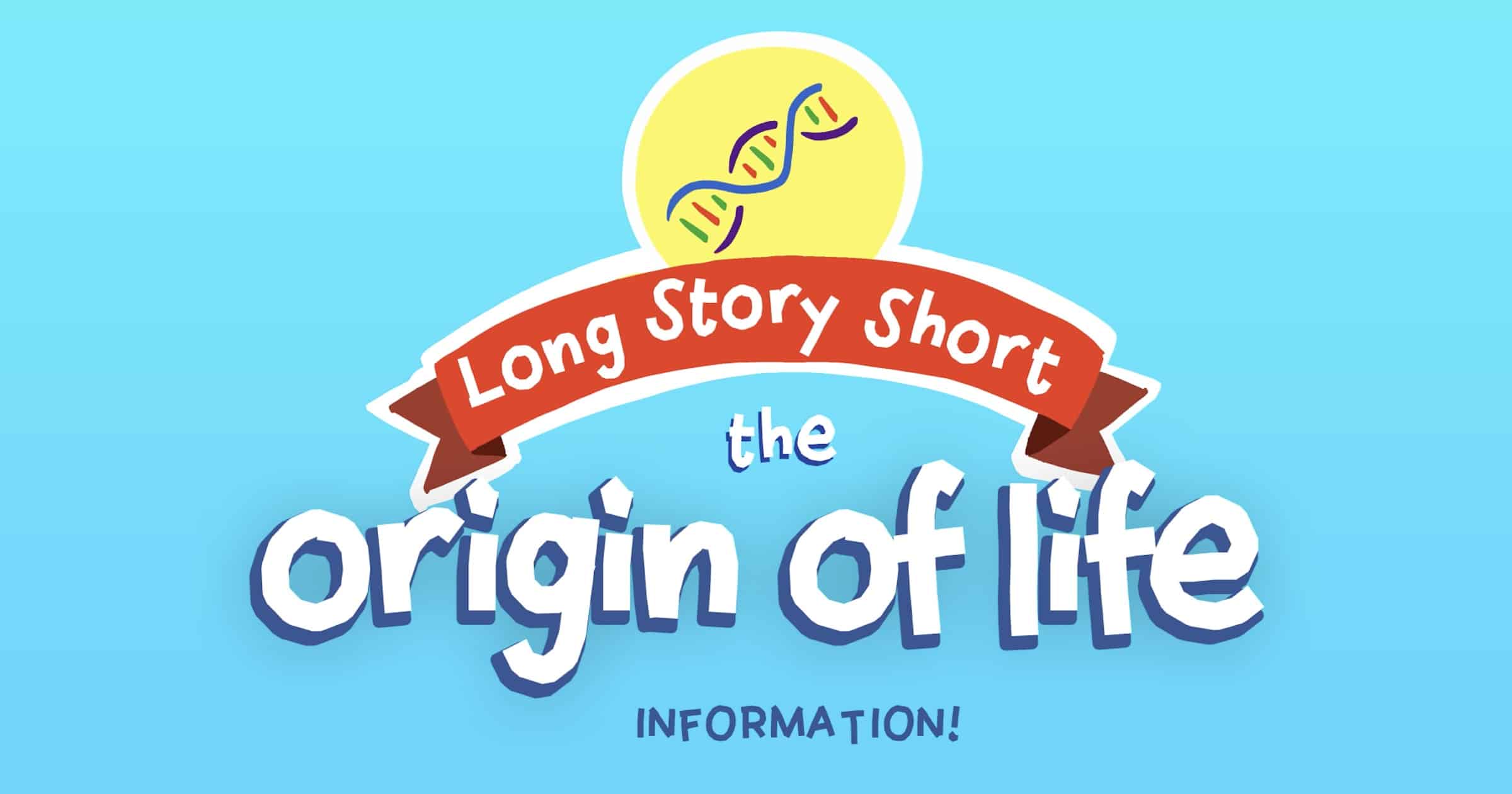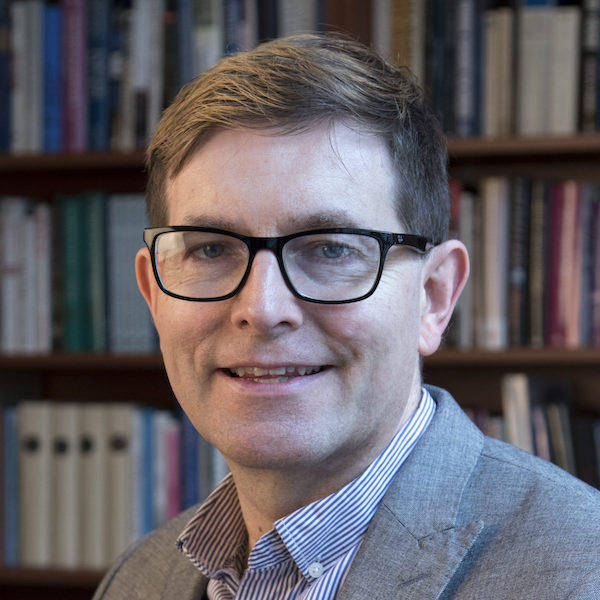 Evolution
Evolution
 Intelligent Design
Intelligent Design
New Long Story Short Video Examines Information and the Origin of Life

Editor’s note: The following article was produced by a completely random process, filtered by natural selection, with no intelligence involved.
Of course, the statement above is patently absurd.1 But those who promote the theory of abiogenesis (the origin of life through purely natural processes) must remain open to accepting it as valid. Why? Because their view asserts a much more extreme case where information — that required for life — arose without the application of intelligence. The latest Long Story Short video addresses this issue: Does the required information for life come from purely natural processes, or from an intelligent mind?
How Much Information Is Required for Life?
The simplest known form of life that can self-replicate in laboratory conditions is JVCI Syn3.0.2 This single-celled organism, a product of human-engineered simplification of an existing pathogen (Mycoplasma mycoides), contains only 473 genes and 531,000 base pairs or “letters” of DNA. This is quite a conservative estimate of the quantity of information needed to sustain life, because this DNA and the information it contains will simply degrade if left alone. To support life, the information in the DNA of JVCI Syn3.0 must be surrounded by additional distributed information: highly organized and functional structures like the membrane, translational machinery, and other proteins, sugars, and RNAs. Further, JVCI Syn3.0 is such a minimal form of life that it cannot survive without coddling by other life forms, including humans.
Thus, for estimating the minimal information content of life, perhaps a more appropriate life form would be the bacterium Candidatus Desulforudis audaxviator.3 This bacterium is able to live independently in the absence of oxygen, generating all of its requirements for survival from simple molecules like C02, H2, water, sulfate, and N2. It’s a robust cell, containing more than 2,100 genes and 2.3 million base pairs of DNA. To put things into perspective, that amount of DNA could store more than 100 articles like this one. Thus, abiogenesis must explain the origin of a large quantity of information — on the order of a megabyte — solely through the actions of physics and chemistry.4
Where Did This Information Come From?
An objective scientist would approach that question by first considering a simple binary choice: either purely natural processes (just physics and chemistry) produced the information, or an intelligent agent was somehow involved. The scientist would then review the available evidence and ask which hypothesis it supports. The hypothesis with the better empirical support should then be adopted, while the scientist remains open to considering possible future evidence.
The only hypothesized purely natural approach for accumulating information in a prebiotic world is chemical evolution: the combination of self-replicating molecules with occasional random errors and natural selection to filter out the molecules with lower “fitness.” This concept was introduced by Sol Spiegelman in 1967.5 Gerald Joyce, an origin-of-life researcher, summarized the evidence in support of the approach in a 2007 review article, “Forty Years of In Vitro Evolution,”6 including this audacious claim:
Chemists can benefit from reflecting on Spiegelman’s studies and the subsequent advances, which have taken the field to the brink of the generation of life itself in the laboratory.
Actual Evidence for Chemical Evolution
Sixteen years later, what can we say? The chemical evolution that Joyce extols clearly suffers from several fundamental limitations. First, the process relies on living organisms (human intellect and intervention, and molecules derived from life) to attempt to show that life could have started without the assistance of living organisms. And second, the research itself has proposed many valid reasons why purely natural chemical evolution cannot occur. For details, see this previous article and this earlier episode of Long Story Short:
Gerald Joyce’s Latest Result
Gerald Joyce’s own recent results7 clearly contradict his claim that we are on “the brink of the generation of life itself in the laboratory.” This work centered on an RNA ribozyme — an RNA molecule with a specific sequence of 188 nucleotides — with the goal of demonstrating a true, self-replicating molecule. Unfortunately, the attempted demonstration was built upon years of human intervention. The entire probabilistic resources of the known universe over all time would be incapable of producing such a complex ribozyme through natural causes.8 Thus, even a successful demonstration of impressive replication would only provide dubious support for abiogenesis. The following is a brief summary of how far scientists are from achieving a true self-replicating molecule, which would be just one very small step toward abiogenesis.
The ribozyme could combine individual nucleotides to synthesize three portions of a simpler version of itself — sort of. Each of the three parts required RNA primers — a 12-nucleotide “head start RNA” — applied to both ends of the template. These primers were conveniently provided by human assistants. The ribozyme then attempted to replicate one of the three parts, using it as a template. However, the newly produced part was tightly bound to the template and would only let go when washed with a solution of 8-molar urea (a laboratory solvent that you’d never find on a prebiotic Earth).
With all of this help, the yield for the ribozyme to produce the three parts was 0.011, 0.01, and 0.057, respectively. With such low yields, it was impossible to combine three successfully produced parts unless the investigators intervened to remove the faulty parts and concentrate the successfully produced parts. The combination of these three successful parts only completed half of the task, though, because it produced the genetic complement of the desired ribozyme. For the desired result, the process had to be repeated to produce the complement of the complement. The second run had a lower yield than the first. So, again, humans had to intervene to remove the faulty parts and concentrate the successfully produced parts.
This leaves aside the fidelity of the copying. The ribozyme introduced many errors in replication — about 1 out of 12 connected nucleotides was incorrect. This is approximately 1 million times less accurate than the least accurate replication process known to support life.9 As a result of so many errors, the ribozymes that were “replicated” were largely useless. In the researchers’ own words: “only a small fraction of the assembled ligases retain catalytic activity due to the presence of disabling mutations.” From this work, Joyce concluded: “Thus, the fidelity of RNA polymerization should be considered a major impediment to the construction of a self-sustained, RNA-based evolving system.” He thereby dramatically succeeded in defeating his own claim that we are on “the brink of the generation of life itself in the laboratory.”
Summing Up the Evidence
We started with a simple binary hypothesis: either purely natural processes (just physics and chemistry) produced the information required to start life, or an intelligent agent was somehow involved. If we are open to following the evidence where it leads, experiments on chemical evolution have taught us that there are numerous serious impediments to the concept, leaving no natural pathway to produce the information required to start life. In contrast, there is much evidence that intelligence produces information. Every human that has ever observed the world, including other humans, has witnessed the production of information from a creative mind. The evidence has spoken. All that’s needed is objective interpretation.
References
- Some may argue, as Richard Dawkins did in Chapter 3 of The Blind Watchmaker, that monkeys typing randomly, followed by a selection process to lock in the preferred letters, followed by asking the monkeys to randomly re-type the non-preferred letters, could eventually generate a work of Shakespeare. However, such a process is merely mining the information that humans have stored inside the selection process. So, no meaningful prose is generated by the action of the monkeys alone.
- Hutchison, C. A., III, et al., Design and synthesis of a minimal bacterial genome. Science, 2016. 351(6280): aad6253.
- Chivian D et al. Environmental genomics reveals a single-species ecosystem deep within earth. Science 2008: 322; 275-278.
- Supporters of abiogenesis will say that life used to be much simpler, requiring far less information. However, there is no evidence to support such a claim. Craig Venter and others have been working to define a minimal cell, which thus far has produced JVCI Syn 3.0 and has helped to define a “boundary” of how simple life could be, while remaining sufficiently robust.
- Mills DR, Peterson RL, Spiegelman S. An extracellular Darwinian experiment with a self-duplicating nucleic acid molecule. Proc. Natl. Acad. Sci. USA 1967: 58; 217 – 224.
- Joyce G. Forty years of in vitro evolution. Angew. Chem. Int. Ed. 2007: 46; 6420-6436. DOI: 10.1002/anie.200701369.
- Tjhung KF, Shokhirev MN, Horning, DP, Joyce GF. “An RNA polymerase ribozyme that synthesizes its own ancestor.” PNAS 2020: 117; 2906-2913.
- Totani, T. Emergence of life in an inflationary universe. Scientific Reports. 2020: 10; 1-7.
- Mycoplasma mycoides and JVCI Syn 3B have the highest recorded mutation rate of any known cell: 1 in 33,000,000 nucleotides are incorrectly copied. Moger-Reischer RZ et al. Evolution of a Minimal Cell. Nature. 2023: 620; 122-127.

